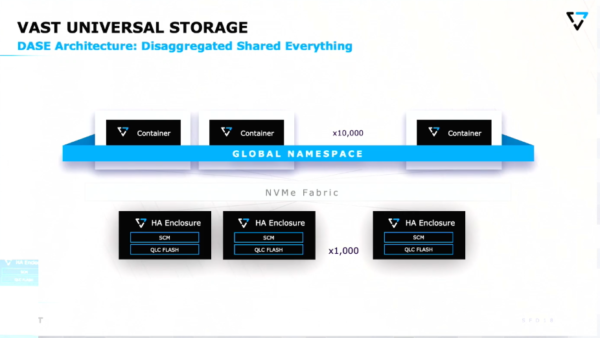Meeting an organization’s storage capacity and storage performance requirements can be a juggling act with multiple storage devices. VAST Data’s design focuses on meeting these needs in a single, cost-effective storage device. It takes advantage of newer storage technology to meet high-performance requirements.
Meeting All Storage Requirements Can Require a Complex Infrastructure
Everyone knows that data is expanding. Organizations are taking in and creating increasing amounts of data. Organizations are keeping data longer. Storing and managing all of this growing data is a challenge.
It isn’t enough to store the data. Companies also need to manage the data’s lifecycle. Many organizations use storage tiering for this, moving data between tiers throughout its life. A typical lifecycle is:
- Collection / generation / active use of the data – The data needs to be on a high-performance storage tier. Organizations often use flash arrays to support this.
- Data that is accessed occasionally – The requirements now emphasize capacity over performance. Most organizations support this tier with hard disk drives.
- Archiving the data – The data is no longer being actively used, but the organization can’t delete it for historical reasons or regulatory compliance. Increasingly, organizations are turning to object storage locally or in the cloud for archive tiers.
Providing all of the needed tiers requires multiple storage volumes and often multiple storage devices. Organizations also need automatic data migration between tiers. This migration often crosses protocol boundaries such as files moving to object storage.
Universal Storage Can Reduce Data Storage Complexity
Universal storage is defined as a single storage device that can provide the protocols and tiers required for data lifecycle management. The simplest way to solve problems associated with storage tiers is to use a single tier for all data. In order to support all performance requirements all-Flash is used for all data. A typical all-Flash array that could provide the required capacity and performance is too expensive.
To reduce cost, universal storage needs to take advantage of Quad-Level Cell (QLC) flash. QLC is generally perceived as “consumer-grade” flash, unable to meet the needs of modern enterprises. “Enterprise-grade” flash most often uses Single-Level Cell (SLC) or Multi-Level Cell (MLC) Flash. Today’s QLC flash is greatly improved over initial offerings. Modern QLC has increased both its transmission speed and life-span endurance while maintaining a lower cost than SLC or MLC.
To meet high-performance requirements, universal storage uses modern protocols and methods of transmission such as Remote Data Memory Access (RDMA) and Non-Volatile Memory express (NVMe). RDMA allows one device to access another device’s memory. NVMe allows devices to transmit data over the Peripheral Component Interconnect express (PCIe) bus.
Introducing VAST Data’s Universal Storage Platform
Founded in 2015, VAST Data introduced their first Universal Storage offering in November of 2018. The company’s stated mission is to end complexity and application performance bottlenecks caused by mechanical media and multiple data tiers. To accomplish this, their goal is to deliver storage that has the convenience of file storage, provides the performance of block storage, and has the scalability of object storage.
VAST Data’s architecture is an exciting departure from legacy storage systems. A “base” unit of VAST Data Universal Storage has:
- 1 Petabyte (PB) of usable capacity
- 1 storage node consisting of Just a Bunch of Flash (JBOF)
- 4 software-defined compute nodes in containers that run on the customer’s choice of servers
That all fits into a single standard Rack Unit (RU).

One PB/RU is impressive, but VAST Data improves upon this by making use of Intel’s 3D CrossPoint Storage Class Memory (SCM). SCM works at speeds slower than server memory, but faster than flash drives. Using SCM as a write buffer, VAST Data adds significant performance. VAST Data also uses both RDMA and NVMe for increased transmission speed.

Currently, VAST Data’s Universal Storage supports both file (NFS) and object (S3) storage with plans to add more protocol support in future versions
Closing Thoughts
Data centers often need to deploy and manage multiple types of storage devices to provide the needed performance and storage tiers. Universal Storage can simplify this complexity using a single device providing a single cost-effective Flash tier. For more information about VAST Data’s Universal Storage Solution, watch their presentation at Storage Field Day 18




